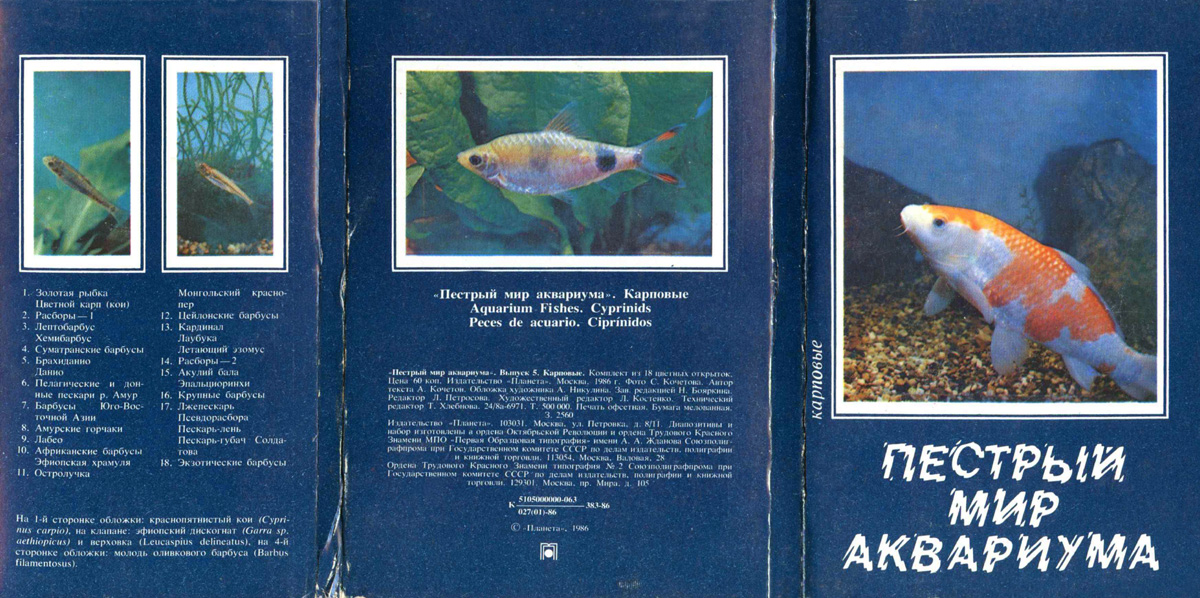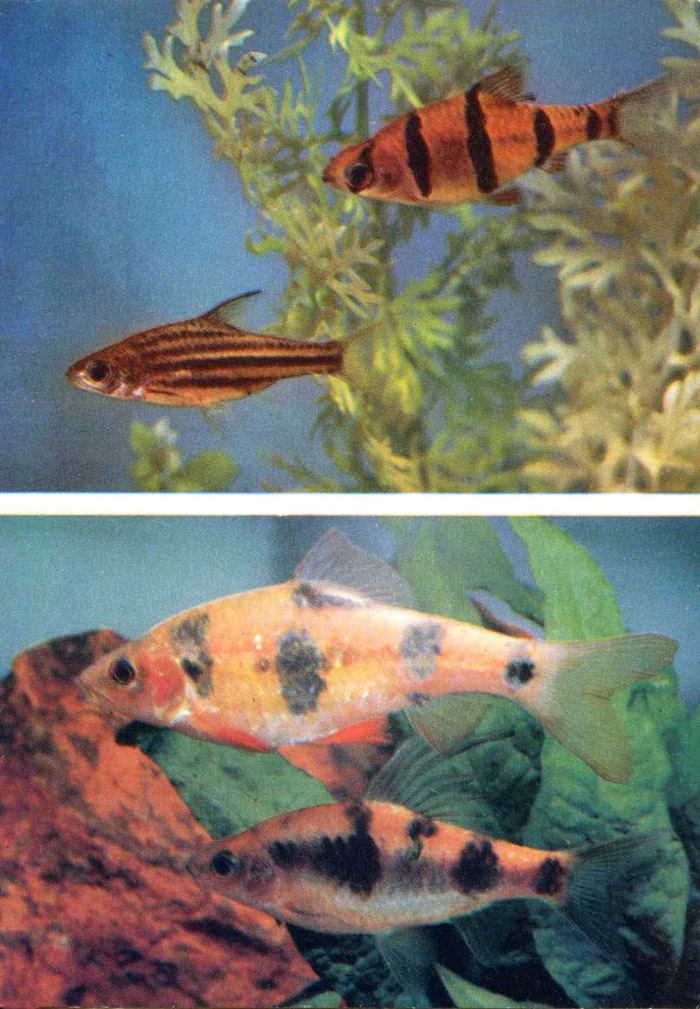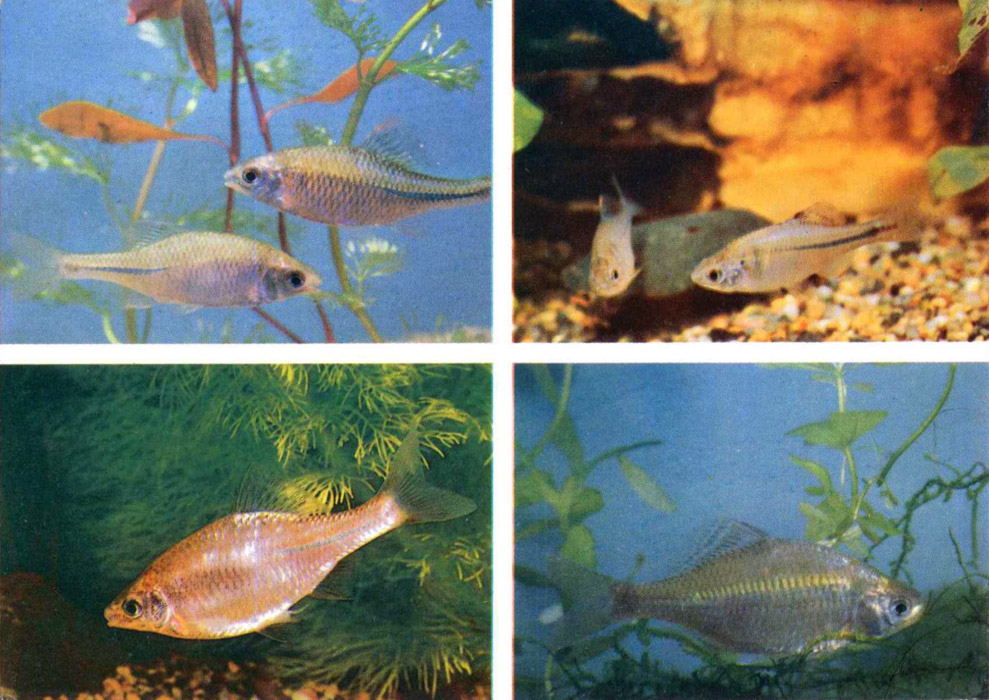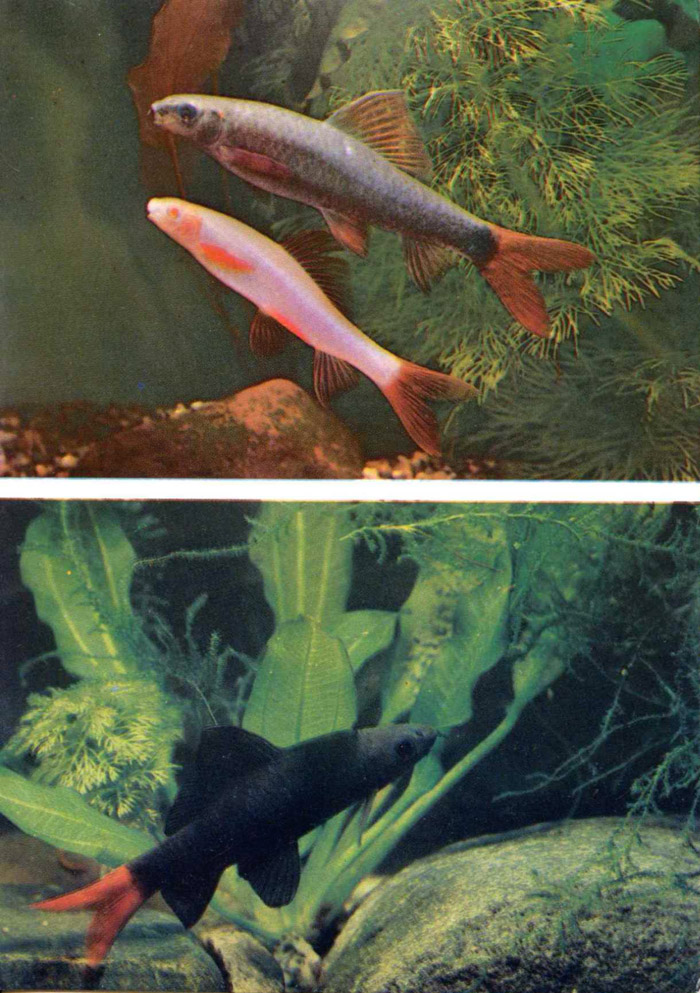Карповые (Cyprinidae) — самое представительное семейств» современных
рыб (275 родов и около 1800 видов). Только в реках и озерах на территории СССР
обитает 58 родов, 126 видов.
Морфологические признаки, общие для карповых: тело покрыто циклоидной чешуей,
реже голое: на нижней стороне черепа роговидное образование (жерновок), служащих
для перетирания пищи: немногочисленные одно-трехрядные глоточные зубы; усиков
нет или не более двух пар (исключение — восьмиусый амурский пескарь).
Местом возникновения карповых был тропический Афро-Азиатский регион (древнейшие
рода — барилии и троегубы). Сегодня они населяют пресные и солоноватые (5—14‰)
воды всех частей света, кроме Австралии, Южной Америки и о. Мадагаскара. Только
дальневосточные красноперки живут при океанической солености — 35‰, а слепые
Caecobarbus geertsi, Caecocypris basimi и Typhlogarra
widdowsoni обосновались
в подземных водоемах.
Карповые питаются фито- и зоопланктоном, бентосными организмами, но есть среди
них хищники (Aspiolucius, Culter, Luciosoma и др.).
любители детрита и перифитона (Discolabeo, Mekongina, Morulius и
т. п.). водной растительности (Scardinus,
Ctenopharyngodon и пр.).
Представители родов Epalzeorhynchus, Garra выполняют функции санитаров, очищая
покровы рыб от паразитов.
Выведение причудливых форм и окрасок золотых рыбок, а также разноцветных карпов
(кои) — многовековая традиция в Китае и Японии.
Половой зрелости эти рыбы, как правило, достигают в 6 — 18 месяцев. Производителей
подбирают из стаи мальков. Самцы обычно мельче, стройнее, ярче окрашены (иногда
на голове, плавниках и верхней части туловища есть роговидные бугорки). За
две-три недели до нереста производителей разделяют и кормят разнообразной пищей.
Толчком к нересту служат: свежая мягкая вода, повышение температуры на 3— 5°
С. Наличие необходимого субстрата, высокая проточность моды, световая обработка
в ночное время (имитация лунных фаз).
Для разведения используют низкие (15 — 50 см), лучше бескаркасные аквариумы
с большой площадью дна. где желательно помести, нерестовые решетки. Нерест
стайный, реже парный. Икра приклеивается к растениям или плавает в толще воды.
У Hyborhynchus, Notropis, Pimephales, Rhinichthys, Campostoma и др. кладку
охраняет самец, а самки Chilogobio, Tanakia и др. прячут икру в мантийную полость
моллюска и различные донные щели. Продуктивность варьирует от 50 до 50 тысяч
и более штук. Для дезинфекции икры воду озонируют или добавляют в нее метиленовую
синь, окситетрациклин (5—10 мг/л) и т. п. Стандартный инкубационный период
18 — 36 часов, еще через 3— 5 дней молодь начинает плавать и питаться «живой
пылью».
Стайный образ жизни, дружелюбность, пестрый наряд делают карповых желанными
гостями в аквариумах.
Cyprinids (Cyprinidae) are the most impressive family of contemporary fishes
(it includes 275 genera and approximately 1,800 species). On the territory
of the USSR only 58 genera and 126 species inhabit rivers and lakes.
Morphologic characteristics common to all Cyprinids are the following: the
body is covered with cycloid scales, seldom naked: on the lower side of the
skull is a spiny protuberance which serves to crush the food: a few pharyngeal
teeth are disposed in one to three rows; barbels are absent, or there are no
more than two pairs (with the exception of the Amur Eight-Barbel Gudgeon —
Gobiobotia pappenheimi).
Cyprinids originate in the tropical regions of Africa and Asia (most archaic
genera are Rajamas (Barilius) and Three-Lips (Opsariichthys)).
Today they inhabit fresh and salty (5-14‰) waters in all parts of the world,
except Australia,
South America and Madagascar. Only the Far-Eastern Pacific Redfins (Tribolodon
sp.) are capable of living in oceanic salinity of 35‰, but the blind Caecobarbus
geertsi, Caecocypris basimi and Typhlogarra widdowsoni have settled down in
underground waters.
Cyprinids feed on phyto- and zooplankton and benthos, but there are among them
carnivores (Aspiolucius, Culter, Luciosoma, etc.).
detritus and periphyton lovers (Discolabeo, Mekongina, Morulius, etc.), as
well as those thriving on
water vegetation (Scardinus, Ctenopharyngodon, etc.).
Specimens of Epalzeoihynchus and Garra genera clear fishes’ covers of parasites.
In China and Japan there is a centuries-old tradition to breed odd forms and
colour varieties of Goldfishes as well as multi-coloured Carps (Koi).
As a rule, Cyprinids reach sexual maturity at the age of 6 to 18 months. Spawners
are selected among a shoal of fry. Males are usually smaller, slimmer and brighter
than females (sometimes there are horny tubercles on the head, fins and upper
side of the body of males). Two to three weeks before expected spawning, adult
fishes are to be separated and fed with varied food. The following stimuli
may provoke the spawning: fresh, soft water, rise in temperature by 3 to 5°
C; necessary substratum availability, high water flowage, lighting at night
(imitation of moon phases).
For breeding it is desirable to use tanks made wholly of glass with low depth
(15 to 50 cm) and a large surface area furnished with spawning grids. Cyprinids
spawn communally, seldom in single pairs. The eggs stick to water plants or
float in open water. Males of Hyborhynchus, Notropis, Pimephalus, Rhinichthys and Campostoma protect the clutch, while females of Chilogohio, Tanakia and
other genera hide the eggs in the mantle cavity of mollusks and bottom cracks.
Fecundity varies from 50 to 50.000 eggs and more. To disinfect the eggs one
may ionize the water or add melhylene-blue, oxytetracyclinum (5 to 10 mg/l)
and so on. Standard incubation period is 18 to 36 hours: three to five days
later the young begin feeding and swimming.
Communal mode of life, friendliness and their multi-coloured dress make Cyprinids
popular with aquarium keepers.
Los ciprinidos (Cyprinidae) constituyen la familia de peces mas numerosa de
nuestros dias (275 generos de 1.800 especies). Tan solo en aguas dulces del
territorio de la URSS habitan 58 generos de 126 especies. Las caracteristicas
morfologicas comunes de los ciprinidos: el cuerpo recubierto de escamas cicloideas:
en algunas especies, desnudo. Una excrecencia cornea en la parte inferior del
craneo que sirve de “muelilla” para triturar el pasto: dientes faringeos formando
de una a tres filas; falta de barbillas o presencia de dos pares de estas tan
solo (salvo la excepcion de Gobiobotia pappenheimi, de ocho barbillas). Por
su lugar de origen se tiene la region afroasiatica. Los generos mas antiguos:
Barilius y Opsariichthys. Actualmente la familia se presenta en aguas dulces
o poco salobres (5-14‰) de casi el mundo entero, menos Australia. America del
Sur y Madagascar. Solo la especie Tribolodon, del Extremo Oriente, habita aguas
de salobridad oceanica (35‰). у las especies ciegas de Caecobarbus geertsi,
Caecocypris basimi y Typhlogarra widdowsoni se adaptaron a las aguas de estanques
subterraneos.
Los ciprinidos se alimentan de fito- y zooplancton organismos del hentos,
pero tambien hay entre ellos peces carniceros (Aspiolucius, Culter, Luciosoma,
etc.), hay amantes de detritus y periphyton (Discolabeo, Mekongina, Morulius,
etc.), como tambien los hay fitofagos (Scardinus, Ctenopharyngodon y otros).
Los Epalzeorhynchus y Garra (algunas de las especies de estos generos) desemplean
el papel de aseadores alimentandose de parasitos exteriores de otros peces.
La seleccion de las carpas doradas de formas y tintes rebuscados, como tambien
la de carpas de colores variados (koi) es una tradicion de muchos siglos en
China y Japon.
Estos peces pubescen generalmente a los 6-18 meses de vida. A los procreadores
se ha de escojerlos de entre la cria joven. Por lo general, los machos suelen
cederles a las hembras en tamano siendo al mismo tiempo mas esbeltos y de colores
mas vivos. En algunas especies, los machos tienen unas excrecencias corneas
en la cabeza, parte superior del tronco y las aletas. Con dos o tres semanas
de antelacion, se los separa a los procreadores del resto de los peces, asegurando
alimento intenso y variado. Los factores que estimulan la muga son el agua
suave y renovada, la elevacion de la temperatura en 3 o 5° C, el substrato
adecuado para la especie, un intenso flujo del agua y alumbramiento nocturno
que imite las fases de la Luna.
Para las mugas se utilizan acuarios de reducida altura (15-50 cm.); son preferibles
acuarios sin armazon alguna y con un vasto fondo. Se aconseja recurrir a unas
rejillas especiales para obstaculizar a los peces el acceso a su propia puesta.
En los mas de los casos, se opera esta de manera gregal, habiendo casos, sin
embargo, en que se celebra en parejas. Los huevos se pegan a las plantas o
flotan en el espesor del agua. En las Hyborhynchus, Notropis, Pimephales, Rhinichthys,
Campostoma y otras especies mas el macho cuida de la puesta. En las Chilogobio,
Tanakia y otras especies afines la hembra logra insertar sus huevos en la cavidad
paleal de los moluscos o albergarlos en rendijas que se presenten en el fondo.
La productividad varia entre 50 y 50 mil huevos y aun mas. Para la desinfeccion
de la puesta se ozoniza el agua o se le adita el azul de metileno, oxitetraciclina
(5-10 mg/l). etc. El periodo embrionario dura, por termino medio, de 18 a 36
horas. A los tres o cinco dias de vida, los alevines empiezan ya a desplazarse
en el agua y procurarse pasto.
 |
1. СИТЦЕВАЯ ОРАНДА ИЛИ ЛЬВИНОГОЛОВКА.
Carassius auratus auratus var. 15—40 см
СИРЕНЕВЫЙ КАРП (КОИ). Cyprinus carpio viridiviolaceus var. До 1,2 м
1. Селекционная форма серебряного карася известна
с 975 — 968 гг. до н. э. Массовая селекция началась при императоре
Чао-Kу, династии Сун (960 — 1279 гг.). Есть 2 группы: со спинным
плавником (вуалехвост, жемчужинка, телескоп, комета и т. д.) и
без него (красная шапочка, небесное око, помпон, водяные глазки
и др.). У самцов на грудных плавниках — пилка, на жаберных крышках
— жемчужная сыпь. Эврифаг. Созревает в 1—2 года. Нерест порционный,
стайный. Аквариум 120x60x50 см. Фитофил. Продуктивность 2 — 10
тыс. икринок. Инкубационный период 2,5 дня, t 22° С, на 5-й день
молодь плывет. Условия содержания: dH до 20°, рН 6.5 — 8.0, t 10—25°
С, аэрация, фильтрация, подмена (1/4 ежедневно) воды. Продолжительность
жизни 12 — 15 лет.
2. Селекционная форма вьетнамского сазана. Есть гладкие и пестрые формы, чешуйчатые
и голые. Созревают в 3— 6 лет. Условия содержания, кормления и размножения как
у золотой рыбки. |
1. Selective variety of wild Goldfish is known since
975-968 B.C. Mass selection began during the reign of emperor Tchiaou-ku
of Sung dynasty (960-1279). There are two groups of fancy Goldfish
varieties: with dorsal fin (Veiltail, Pearlscale, Telescope, Comet,
and so on) and without it (Red-Cap, Celestial, Pompom, Bubble-Eye,
etc). Males possess tubercles on pectoral fins and pearly dots
on gill covers. Euryphagous. Sexually matures at 1 to 2 years.
Intermittent spawning, in schools. Tank dimensions: 120x60x50 cm.
Phytophil. Fecundity 2,000 to 10,000 eggs. Incubation period 2.5
days at 22° C, the young begin swimming on the 5th day. Care: dH
10 20°, pH 6.5-8.0, temperature, 10 to 25° C. 1/4 of the water
should be changed daily. Longevity, 12 to 15 years.
2. Selective form of Vietnamese wild carp. There are smooth, multi-coloured,
scaled and naked forms. Sexually mature at 3 to 6 years. Care, feeding and breeding
as mentioned above for the Goldfish. |
1. Variedad selectionada del carasio plateado, conocida desde
975-968 а.n.e. Su extensiva seleccion comenzo con el emperador
Chou-Hi, de la dinastia Song (960-1.279). Se conocen dos tipos
de estas variedades: con aleta dorsal y sin ella. Los machos se
distinguen por las aletas pectorales con la primera espina dentada
y los operculos moteados de perlas. Los peces son omnivoros y pubescen
a 1-2 anos de vida. La puesta se opera de manera gregal e intermitente.
El acuario ha de ser de 120x60x50 crn. Fitofilo. Productividad:
de 2 a 10 mil huevos. El periodo embrionario: unos 2,5 dias; t
—22° C; al quinto dia la cria empieza a desplazarse independiente.
Condiciones vitales: dH—hasta 20°; pH—6,5-8,0; t—10-25° C. Aireacion,
filtracion y renovacion U/4 parte diaria) del agua. Viven de 12
a 15 anos.
2. Variedad seleccionada de la carpa vietnamita. Hay formas mono- y policromas,
escamadas y desnudas. Pubescen a los 3-6 anos de vida. Las condiciones vitales,
de alimentacion y procreacion son iguales a las del pez dorado. |
 |
Фото С. Кочетова. «Пестрый мир аквариума».
Выпуск 5. Карповые.
© «Планета», Москва, 1986. 24/8а-6971. Т. 500000. Ц. 3 коп. З. 2560. Тип.
.№ 2.
ОТПРАВЛЯТЬ ПО ПОЧТЕ ТОЛЬКО В КОНВЕРТЕ |
|
 |
2. КЛИНОПЯТНИСТАЯ РАСБОРА. Rasbora
heteromorpha. 4,5 см
РАСБОРА-КОЛИБРИ, ИЛИ ПЯТНИСТАЯ РАСБОРА. R. maculata. 2.5 см
КАРЛИКОВАЯ РАСБОРА, ИЛИ РАСБОРА-СВЕТЛЯЧОК. R. urophthalma. 3 см
КИТАЙСКАЯ РАСБОРА. R. steineri. 7,5 см
КРАСНОПОЛОСАЯ РАСБОРА. R. pauciperforata. 7 см
Населяют водоемы Юго-Восточной Азии. Самцы ярче, стройнее
самок. Животноядные виды. Созревают в 4—8 месяцев. Важно подобрать
активных производителей. Нерест порционный. Фитофилы. Продуктивность
мелких видов — 50 икринок, остальных 250 — 600 шт. Инкубационный
период 20—40 часов. Икра и личинка имеют отрицательный фототаксис,
Условия содержания: dH 2—15°, рН 6,0 — 7,5, t 22 — 28° С и т. д.
Интерес представляют также: R. taeniata — 7 см, R.
cephalotaenia — 12 см. R. dusonensis — 12 см, R.
einthoveni — 8,5 см и R. kalochroma — 5 см. |
Inhabit waters of South-East Asia. Males brighter,
slimmer than females. Zoophagous. Sexually mature at 4 to 8 months.
Selection of active spawners is very important. Intermittent spawning.
Phytophils. Fecundity of small species 50 eggs, other species —
250 to 600 eggs. Incubation period 20 to 40 hours. The eggs and
the fry show negative phototaxis. Care; dH 2 to 15°. pH 6.0-7.5,
temperature, 22 to 28° C, etc. R. taeniata — 7 cm., R.
cephalotaenia — 12 cm. R. dusonensis — 12 cm. R.
einthoveni — 8.5 cm and R. kalochroma — 5 cm are also of some interest. |
Pueblan aguas dulces del Asia sudoriental. Los machos son mas
esbeltos y vistosos que las hembras. Las especies son carnivoras.
Pubescen a los 4-8 meses. Lo importante es escoger procreadores
activos. Son fitofilos. La puesta es intermitente. La productividad
de las especies menores es de unos 50 huevos, y de las demas especies,
250-600. El periodo embrionario dura de 20 a 40 horas. Tanto los
huevos como los alevines se caracterizan por la fototaxis negativa.
Condiciones vitales: dH 2-15°; pH 6,0-7,5: t 22-28° C. etc. Tambien
son de interes: R. taeniata de unos 7 cm; R. cephalotaenia, 12
cm; R. dusonensis, 12 cm; R. einthoveni, 8.5 cm, y R.
kalochroma,
5 cm. |
 |
Фото С. Кочетова. «Пестрый мир аквариума».
Выпуск 5. Карповые.
© «Планета», Москва, 1986. 24/8а-6971. Т. 500000. Ц. 3 коп. З. 2560. Тип.
.№ 2.
ОТПРАВЛЯТЬ ПО ПОЧТЕ ТОЛЬКО В КОНВЕРТЕ |
|
 |
4. ОСТРОВНОЙ УСАЧ, ИЛИ БАРБУС ОЛИГОЛЕПИС.
Barbus oligolepis. 5 см
СУМАТРАНСКИИ БАРБУС. B. tetrazona. 7 см
Населяют водоемы о. Суматра. Самцы ярче, стройнее
самок. Окраска вариативна, есть альбиносы. Кормление общее для
рода. Созревают в 5 — 7 месяцев. Нерест парный. Размер аквариума
30x20x20 см. Фитофилы. Продуктивность 300 — 1000 икринок. После
нереста часть воды (до 1/3) заменяют. Инкубационный период 1,5
— 2 дня, еще через 3 суток молодь плывет. Стартовый корм: коловратка,
науплии артемии и др. Условия содержания; dH до 15°, рН 6.5 — 7,5.
t 22 —26° С (max.—34° С), аэрация, фильтрация, подмена воды (1/3
еженедельно). Близкие виды; B. fasciatus — 15 см, B.
foerschi —
4 см, B. rhomboocellatus — 5 см и B. roloffi — 4 см. В «Красную
книгу» МСОП занесено 16 видов барбусов, среди них: B. cumingi,
B. nigrofasciatus, B. titteya и Caecobarbus greertsi. |
Inhabit waters of Sumatra Island, Males brighter
and slimmer than females. Colour pattern varies, albino forms are
known. Feeding common for the genus. Sexually mature at 5 to 7
months. Spawning in single pairs. Tank dimensions: 30x20x20 cm.
Phytophils. Fecundity 300 to 1.000 eggs. A part (up to 1/3) of
the water should be changed after spawning. Incubation period 1.5
to 2 days, 3 days later the young start swimming. Starting food:
rotifers, brine shrimp nauplii, etc. Care: dH to 15°, pH 6.5-7.5,
temperature, 22 to 26° С (34° С maximum), aeration, filtration,
1/3 of the water must be changed weekly. Close species: B .fasciatus,
4—15 cm, B. foerschi — 4 cm, B. rhomboocellatus — 5 cm and B.
roloffi — 4 cm. Sixteen species of Barbs are mentioned in the Red Data
Book of IUCN, among them: B. cumingi, B. nigrofasciatus, B.
titteya and Caecobarbus geertsi. |
Pueblan las aguas de Sumatra.
Los machos son mas esbeltos y de colores mas vivos que las hembras.
Son de colores diferenres, hay
albinos. El pasto es el mismo de (odo el genero. Pubescen a los
5-7 meses; la puesta, en parejas. Dimensiones del acuario: 30x20x20
cm. Fitofilos. Productividad: 300-1.000 huevos. Efectuada la puesta,
el agua del acuario se ha de renovarla en parte (hasta 1/3). El
periodo embrionario es de 1,5-2 dias, y a los tres dias mas las
crias empiezan su vida independiente. El pasto inicial: rotiferos,
nauplios. etc. Condiciones vitales: dH — hasta 15°; pH 6,5-7.5;
t 22-26° С (34° С, al maximo): aireacion, filtracion y renovacion
del agua (1/3 del total a la semana). Especies afines: B. fasciatus,
35 cm; B. foerschi, 4 cm: B. rhomboocellatus, 5 cm;
y B. roloffi, 4 cm. Dieciseis especies de los barbus — B.
cumingi,
B. nigrofasciatus,
B. titteya y Caecobarbus geertsi entre ellas — estan inscritas
en el Libro Rojo. |
 |
Фото С. Кочетова. «Пестрый мир аквариума».
Выпуск 5. Карповые.
© «Планета», Москва, 1986. 24/8а-6971. Т. 500000. Ц. 3 коп. З. 2560. Тип.
.№ 2.
ОТПРАВЛЯТЬ ПО ПОЧТЕ ТОЛЬКО В КОНВЕРТЕ |
|
 |
5. РОЗОВЫЙ ДАНИО. Brachydanio
albolineatus. 6 см
ЛЕОПАРДОВЫЙ ДАНИО. Br. rerio var. frankei. 6 см
ДАНИО-РЕРИО, ИЛИ ЗЕБРОВЫЙ ДАНИО. Br. rerio. 6 см
МАЛАБАРСКИЙ ДАНИО. Danio aequipinnatus. 8—12 см
ДАНИО ДЕВАРИО. D. devario. 8— 15 см
Населяют реки Индии, о. Суматры и Шри-Ланки. Самцы
ярче и мельче самок. Корм: насекомые и их личинки, планктон и т.
л. Полезно подкармливать рыб энхитреями. Созревают в 4—8 месяцев.
Нерест порционный, стайный. Активизируют его свежая теплая вода
и яркий солнечный свет. Размер аквариума 60 — 30x25x25 — 30 см.
Фитофилы. Продуктивность Brachydanio 200 — 500 икринок (икру едят),
Danio 0,5—3 тыс. штук. Инкубационный период 1 — 2 дня, еще через
2 — 3 дня молодь плывет. Стартовый корм: коловратка, порошковый,
жидкий комбикорма и т. д. Условия содержания: dH до 20°, рН 6.5
— 8,0, t 20 — 30° С (min. — 17° С) и т. д. Близкие виды: Br.
kerri — 5 см (Таиланд), Br. nigrofasciatus — 4,5 см (Бирма) и D.
regina — 12 см (Таиланд). Продолжительность жизни 3 — 5 лет. Все виды
гибридизируются между собой. |
Inhabit rivers of India, and Sumatra and Sri Lanka islands. Males
brighter and smaller than females. Food: insects and its larvae,
plankton, etc. Feeding up with enchytrae is efficient. Sexually
mature at 4 to 8 months. Intermittent spawning, in schools. The
spawning may be stimulated by fresh warm water and bright sun light.
Tank dimensions: 60 to 30x25x25 to 30 cm. Phytophils. Brachydanio
fecundity 200 to 500 eggs (spawners eat their eggs), Danio — 500
to 3,000 eggs. Incubation period 1 to 2 days, 2 to 3 days later
the young start swimming. Starting food: rotifers, powder and liquid
combined foods, etc. Care: dH to 20°, pH 6.5-8.0, temperature,
20 to 30° С (17° С minimum). Close species: Br. kerri — 5 cm (Thailand).
Br. nigrofasciatus — 4.5 cm (Burma) and D. regina — 12 cm (Thailand).
Longevity, 3 to 5 years. Hybridization between all these species
is possible. |
Pueblan rios de la India, Sumatra y Sri Lanka. Los machos son
mas vistosos que las hembras, cediendo a estas en tamano. Pasto:
insectos y sus larvas, plancton, etc. Es aconsejable incluir enchytrae.
Pubescen a los 4-8 meses. La muga es gregal; la puesta, en varias
porciones. La procreacion es estimulada por el agua renovada y
tibia y la intensa luz solar. Dimensiones del acuario: 60-30x25x25-30
cm. Fitofilos. La productividad de Brachydanio es de 200 a 500
huevos (los peces adultos de la especie son dados a comerselos);
Danio, 0.5-3 mil huevos. El periodo embrionario es de 3-2 dias,
y a unos 2-3 dias mas los alevines empiezan ya a desplazarse independientes.
El pasto inicial: rotiferos, alimentos liquidos y triturados, etc.
Condiciones vitales: dH hasta 20°; pH 6,5-8,0; t 20-30° С (17°,
la minima) etc. Especies afines: Br. kerri, 5 cm., Tailandia; Br.
nigrofasciatus, 4,5 cm. Birmania, y D. regina, 12 cm, Tailandia.
Viven de 3 a 5 anos. Todas las especies son posibles de cruzarse.
|
 |
Фото С. Кочетова. «Пестрый мир аквариума».
Выпуск 5. Карповые.
© «Планета», Москва, 1986. 24/8а-6971. Т. 500000. Ц. 3 коп. З. 2560. Тип.
.№ 2.
ОТПРАВЛЯТЬ ПО ПОЧТЕ ТОЛЬКО В КОНВЕРТЕ |
|
 |
6. ХАНКИНСКИЙ ПЕСКАРЬ. Gnathopogon
chankaensis. 5—10 см
ВЛАДИСЛАВИЯ. Ladislavia taszanowskii. До 15 см
КИТАЙСКИЙ ЯЩЕРНЫЙ ПЕСКАРЬ. Saurogobio dabryi. До 24 см
АМУРСКИЙ НОСАТЫЙ ПЕСКАРЬ. Microphysogobio amurensis. До 12 см
Населяют р. Амур. Самцы обычно мельче, стройнее и
ярче самок. Корм: животный — 80% и растительный — 20%. Нерест порционный,
стайный. Созревают в 1—2 года.
1. Фитофил. Продуктивность 1—3 тыс. икринок (d~1,2 мм). Инкубационный период
3,5 дня, еще через 2 — 3 дня молодь плывет. Близкие виды: G. japonicus — 12 см,
G. biwae — 12 см и G. gracilis — 8 см (Япония).
2. Фитофил. Продуктивность 0,5 — 3 тыс. икринок (d~1,8 мм). Инкубационный период
3,5 дня, t 22° С.
3 и 4. Пелагофилы. Продуктивность 5—30 тыс. икринок (d~2,9 мм). Инкубационный
период 1,5 — 3 дня, еще через 3 — 8 дней молодь плывет. Стартовый корм: мельчайший
планктон. Продолжительность жизни 4 — 7 лет. |
Inhabit the Amur River. Males usually smaller, slimmer
and brighter than females. Food: 80% animal and 20% vegetable.
Intermittent spawning, in schools. Sexually mature at 1 to 2 years.
1. Phytophil. Fecundity 1.000 to 3,000 eggs (d~l,2 mm). Incubation period 3.5
days. 2 to 3 days later the young start swimming. Close species: G. japonicus— 12 cm, G.
biwae — 12 cm and G. gracilis — 8 cm (Japan).
2. Phytophil. Fecundity 500 to 3.000 eggs (d~1.8 mm). Incubation period 3.5 days
at 22° C.
3 and 4. Pelagophils. Fecundity 5,000 to 30,000 eggs (d~2.9 mm). Incubation period
1.5 to 3 days, 3 to 8 days later the young start swimming. Starting food: smallest
plankton. Longevity, 4 to 7 years. |
Habitan las aguas del rio Amur. Los machos son de colores mas
subidos y mas garbosos que las hembras, pero menores de tamano.
Pasto: animal (80%) y vegetal (20%). La puesta se efectua en varias
porciones siendo gregal. Los peces pubescen en 1-2 anos.
1. Fitofilo. Productividad: 1-3 mil huevos (D=l,2mm). El periodo embrionario
es de 3,5 dias; a los 2 o 3 dfas mas la cria empieza a desplazarse en el agua.
Especies afines: G. japonicus, 12 cm.; G. biwae, 12 cm., y G.
gracilis. 8 cm.,
Japon.
2. Fitofilo. Productividad: 0,5-3mil huevos (D=l,8 mm). El periodo embrionario
es de 3.5 dias; t 22° C.
3 y 4. Pelagofilos. Productividad: 5-30 mil huevos (D=2,9 mm). El periodo embrionario
es de 1,5 a 3 dias; en unos 3-8 dias mas la cria empieza a procurarse el sustento
por su propia cuenta. El pasto inicial: plancton minusculo. Viven de 4 a 7 anos. |
 |
Фото С. Кочетова. «Пестрый мир аквариума».
Выпуск 5. Карповые.
© «Планета», Москва, 1986. 24/8а-6971. Т. 500000. Ц. 3 коп. З. 2560. Тип.
.№ 2.
ОТПРАВЛЯТЬ ПО ПОЧТЕ ТОЛЬКО В КОНВЕРТЕ |
|
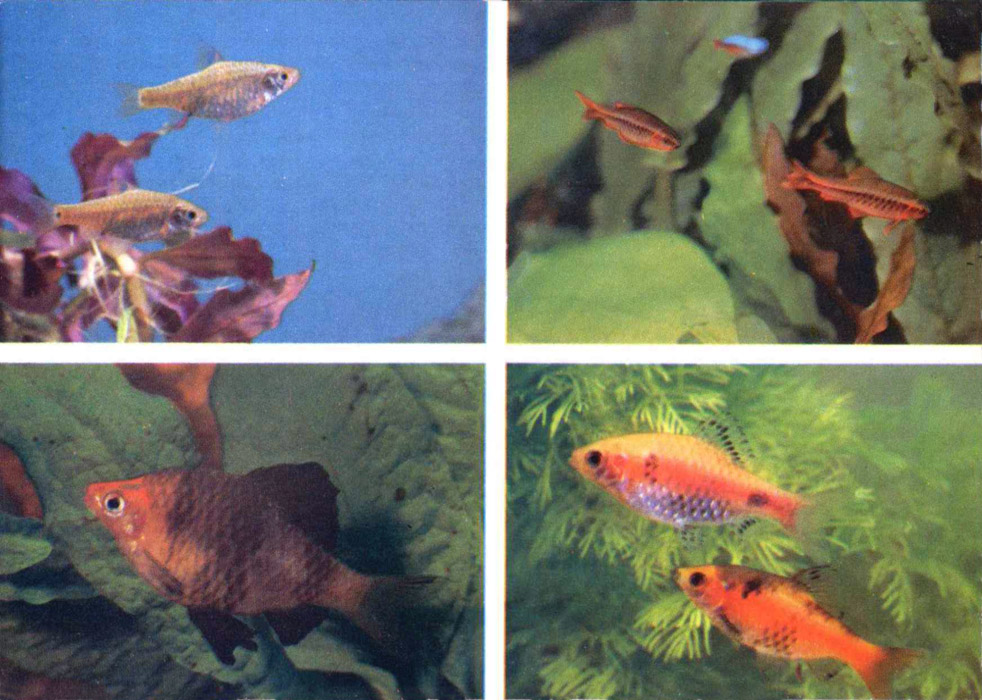 |
12. ЦЕЙЛОНСКИЙ БАРБУС. Barbas
vittatus.
6см
ВИШНЕВЫЙ БАРБУС. В. titteya. 5 см
ЧЕРНЫЙ БАРБУС. В. nigrofasciatus. До 6,5 см
АЛЫЙ ОДЕССКИЙ БАРБУС. В. ticto. 7—10 см
Населяют водоемы о. Шри-Ланки. Самцы стройнее самок,
ярче окрашены (особенно в брачную пору). Производителей перед нерестом
полезно подкармливать энхитреями. Созревают в 5—8 месяцев. Нерест
порционный (6 раз через каждые 15 дней). Стенки аквариума (кроме
смотровой) затемняют. Продуктивность до 1000 прозрачных икринок
(обычно 200—500). Инкубационный период 24—36 часов. Условия содержания
и кормления общие для рода. Между собой скрещиваются B. nigrofasciatus х B.
conchonius х B. ticto х В. stoliczkae, есть вуалевые формы.
Из цейлонских барбусов для аквариумистов представляют интерес:
B. cumingi —5 см и B. bimaculatus — 7 см. |
Inhabit waters of Sri Lanka. Males slimmer and brighter
than females (during breeding season especially). Feeding up with
enchytrae before breeding is efficient for spawners. Sexually mature
al 5 to 8 months. Intermittent spawning (6 times every 15 days).
All sides of the tank (except vision) should be darkened. Fecundity
up to 1,000 transparent eggs (200 to 500 usually). Incubation period
24 to 36 hours. Care and feeding common for the genus. Hybridization
B. nigrofasciatus x B. conchonius x B.
ticto x B. stoliczkae is
possible, veiltail forms are known. From Ceylonese Barbs B.
cumingi — 5 cm and B. bimaculatus — 7 cm are also of interest to the hobbyists. |
Habitan en las aguas dulces de Sri Lanka. Los machos son mas
esbeltos y de colores mas vivos que las hembras, sobre todo en
la epoca de muga. Es aconsejable, antes de la muga, incluir en
la racion de los peces las enchytrae. Pubescen a los 5-8 meses,
La puesta se efectua en seis porciones con intervalos de 15 dias.
Para este periodo se tapan las paredes del acuario menos la frontal.
Productividad: hasta mil huevos transparentes (habitualmente, de
200 a 500). El periodo embrionario dura de 24 a 36 horas. Condiciones
vitales: comunes del genero. Son factibles cruzamientos entre B.
nigrofasciatus x B. conchonius x B. ticto x B.
stoliczkae. De los
Barbus ceilaneses ofrecen interes: B. cumingi, 5 cm., y B.
bimaculatus,
7 cm. |
 |
Фото С. Кочетова. «Пестрый мир аквариума».
Выпуск 5. Карповые.
© «Планета», Москва, 1986. 24/8а-6971. Т. 500000. Ц. 3 коп. З. 2560. Тип.
.№ 2.
ОТПРАВЛЯТЬ ПО ПОЧТЕ ТОЛЬКО В КОНВЕРТЕ |
|
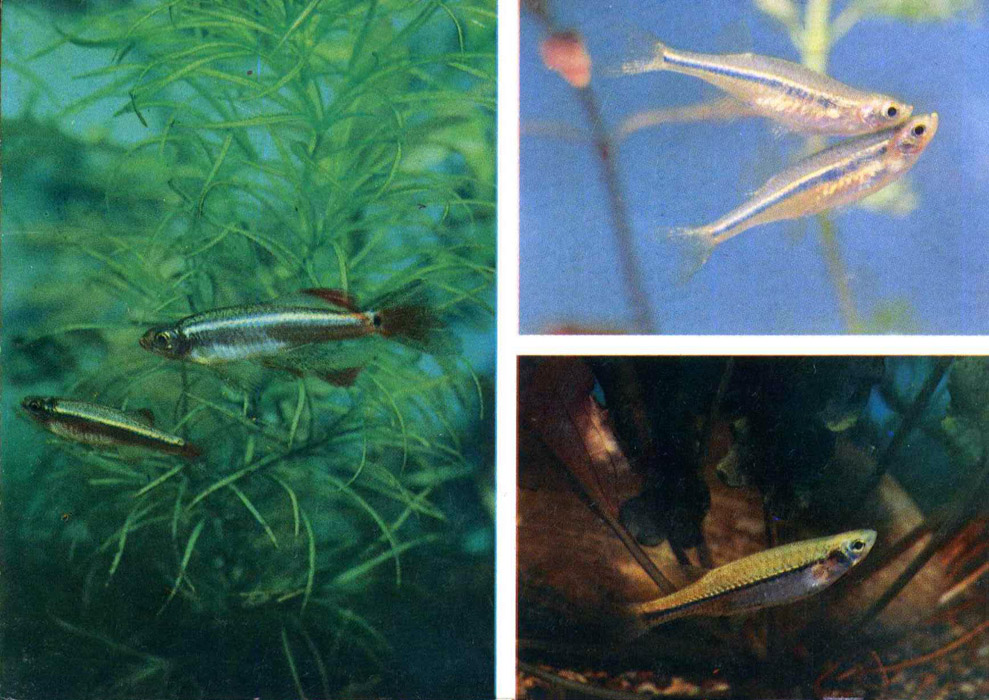 |
13. КАРДИНАЛ. Tanichthys
albonubes.
До 5 см
ЛАУБУКА, ИЛИ ЗОЛОТОЙ НОС. Chela dadyburjori, 3,5 см
ЛЕТАЮЩИЙ ЭЗОМУС. Esomus danrica. 8—15 см
1. Населяет реки Китая. Самец ярче, стройнее самки.
Корм: планктон и т. п. Созревает в 4 месяца. Нерест порционный,
стайный. Аквариум — 25x20x15 см. Фитофил. Продуктивность 150 —
300 икринок. Инкубационный период 1,5—2 дня, на 5—7-й день молодь
плывет. Условия содержания: dH до 15°, рН 6,8—7.8, t 15 — 28°С
и т. д. Продолжительность жизни 4 года. Близкий вид: Hemigrammocypris
lini — 3,5 см (Гонконг).
2. Населяет реки Юго-Восточной Азии. Самец ярче, мельче. Около 150 икринок рыбки
откладывают на лист растения (сверху). Инкубационный период — сутки. Близкий
вид: Ch. laubuca — 6 см. Условия содержания и кормления общие с расборами.
3. Населяют реки Юго-Восточной Азии. Самец мельче. Насекомоядный вид. Созревает
в 5 — 8 месяцев. Нерест порционный, парный. Фитофил. Продуктивность до 700 икринок.
Инкубационный период 1 — 2 дня (t 25—28° С), остальное как у данио. Близкие виды:
E. goddardi — 8 см., E. lineatus — 6 см, E. malayensis — 8 см. |
1. Inhabits rivers of China. Male brighter and slimmer
than female. Food: plankton, etc. Sexually matures at 4 months.
Intermittent spawning, in schools. Tank dimensions: 25x20x15 cm.
Phytophil. Fecundity 150 to 300 eggs. Incubation period 1.5 to
2 days; 5 to 7 days later the young start swimming. Care: dH to
15°, pH 6.8-7.8, temperature, 15 to 28° C, etc. Longevity, 4 years.
Close species: Hemigrammocypris lini — 3.5 cm (Hong Kong).
2. Inhabits rivers of South-East Asia. Male brighter and smaller than female.
About 150 eggs are laid on the upper side of the leaf. Incubation period 24 hours.
Close species: Ch. laubuca — 6 cm. Care and feeding common for Rasboras.
3. Inhabits rivers of South-East Asia. Male smaller. Insectivorous. Sexually
matures at 5 to 8 months. Intermittent spawning, in single pairs. Phytophil.
Fecundity up to 700 eggs. Incubation period 1 to 2 days at 25 to 28° C, the rest
— as described for Danios. Close species: E. goddardi — 8 cm. E.
lineatus — 6
cm, E. malayensis — 8 cm. |
1. Pueblan los rios de China. Los machos son mas vivos de colores
y tienen mas garbo que el sexo opuesto. Pasto: plancton, etc. Pubescen
a los 4 meses. Hacen la puesta en forma gregal, varias porciones
cada hembra. Dimensiones del acuario: 25x20x15 cm, Fitofilos. Productividad:
150-300 huevos, el periodo embrionario dura 1,5-2 dias, al quinto
o, cuando mas, septimo dia la cria empieza a desplazarse por su
propia cuenta. Condiciones vitales: dH hasta 15°; pH 6,8-7,8; t
15-28° C. etc. Viven 4 anos. Especie afin: Hemigrammocypris
lini,
3,5 cm., Hong-Kong.
2. Pueblan los rios del Sudeste de Asia. Los machos son mas menudos y tambien
mas coloridos. Unos 150 huevos deja la hembra sobre hojas de alguna planta acuatica.
El periodo embrionario es de un dia con su noche. Especie afin: Ch. laubuca,
6 cm. Condiciones de cria y alimentacion son las mismas de las especies tipo
Rasbora.
3. Pueblan los rios del Sudeste de Asia. Los machos ceden en tamano a las hembras.
Son insectivoros. Pubescen a los 5-8 meses. La puesta se realiza en porciones,
formando los peces parejas para este periodo. Fitofilos. Productividad: hasta
700 huevos. El periodo embrionario es de 1-2 dias (t 25-28° C); las demas caracteristicas
son similares a estas de las especies tipo Danio. Especies afines: E. goddardi,
8 cm.: E. lineatus, 6 cm.; E. malayensis, 8 cm. |
 |
Фото С. Кочетова. «Пестрый мир аквариума».
Выпуск 5. Карповые.
© «Планета», Москва, 1986. 24/8а-6971. Т. 500000. Ц. 3 коп. З. 2560. Тип.
.№ 2.
ОТПРАВЛЯТЬ ПО ПОЧТЕ ТОЛЬКО В КОНВЕРТЕ |
|
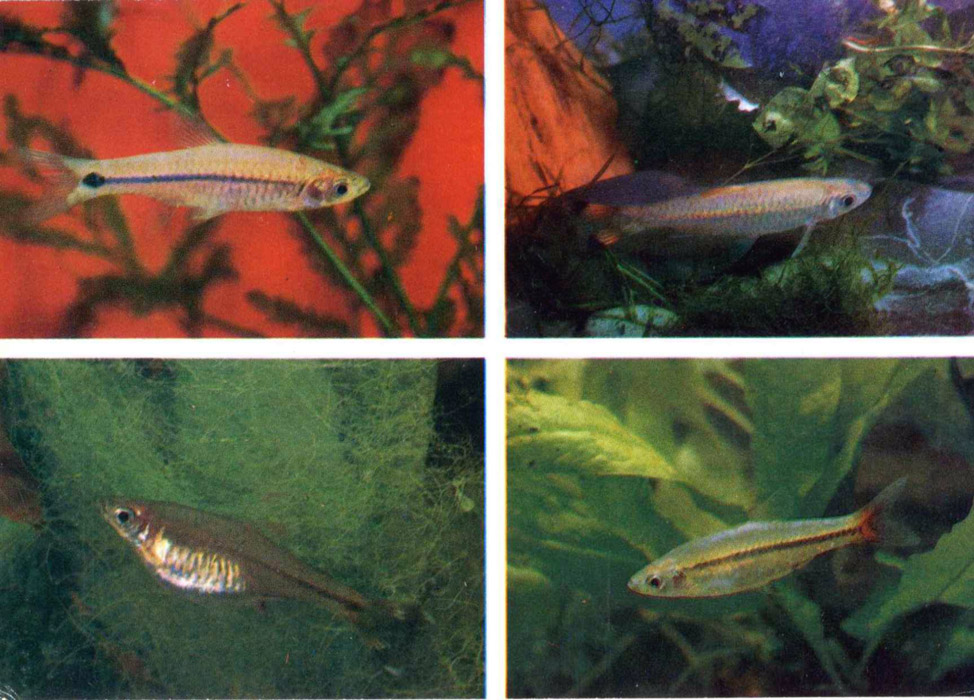 |
14. СУМАТРАНСКАЯ РАСБОРА. Rasbora
sumatrana. 10 — 19см
ПЕСТРОХВОСТАЯ РАСБОРА. R. caudimaculata. До 12 см
ТРЕХЛИНЕЙНАЯ РАСБОРА. R. trilineata. 15 см
КРАСНОХВОСТАЯ РАСБОРА. R. borapetensis. 5 см
Населяют реки Таиланда, Малайзии, о. Суматры и Борнео.
Известно около 45 видов расбор. Самцы мельче, стройнее самок, ярче
окрашены. Корм: насекомые и их личинки, планктон и т. д. Созревают
в 5 — 8 месяцев. Нерест порционный, парный, до 6 раз в год. Размер
нерестового аквариума; 60—30 х 30—20 х 35—20 см. Фитофилы. Продуктивность
300 — 600 икринок. Инкубационный период 24 — 36 часов, через 3
— 4 дня молодь плывет. Стартовый корм: коловратка и т. п. Самый
крупный вид — R. elanga — 20 см, мелкие — R. hengeli — 3 см, R.
dorsiocellata — 3,5 см, R. somphongsi — 3 см и R.
vaterifloris — 4 см. Продолжительность жизни 3 — 5 лет. |
Inhabit rivers of Thailand, Malaysia. Sumatra and
Borneo islands. About 45 species of Rasboras are known. Males smaller,
slimmer and brighter than females. Food: insects and their larvae,
plankton, etc. Sexually mature at 5 to 8 months. Intermittent spawning,
in single pairs, up to 6 times a year. Spawning tank dimensions:
60 to 30 x 30 to 20 x 35 to 20 cm. Phytophils. Fecundity 300 to
600 eggs. Incubation period 24 to 36 hours, 3 to 4 days later the
young start swimming. Starting food: rotifers, etc. The largest
species: R. elanga — 20 cm, small species: R. hengeli — 3 cm, R.
dorsiocellata — 3.5 cm, R. somphongsi — 3 cm and R.
vaterifloris — 4 cm. Longevity 3 to 5 years. |
Son habitantes de los rios de
Tailandia, Malasia, las islas de Sumatra y Borneo. Se conocen
cerca de 45 especies. Los machos ceden
a las hembras en tamano superandolas en la vivacidad del tinte.
Pasto: insectos y sus larvas, plancton, etc, Pubescen los peces
a los 5-8 meses. Las mugas — hasta 6 veces al ano — las celebran
en parejas, haciendo puestas en varias porciones. Dimensiones del
acuario para mugas: 60-30 x 30-20 x 35-20 cm, Fitofilos. Productividad:
300-600 huevos. El periodo embrionario es de 24-36 horas. De 3
a 4 dias mas tarde los alevines empiezan a desplazarse en el agua.
Pasto inicial: rotiferos, etc. La especie mas grande: R. elanga,
20 cm.; especies menores: R. hengeli, 3 cm.; R. dorsiocellata,
3.5 cm; R. somphongsi, 3 cm., y R. vaterifloris,
4 cm. Viven de 3 a 5 anos. |
 |
Фото С. Кочетова. «Пестрый мир аквариума».
Выпуск 5. Карповые.
© «Планета», Москва, 1986. 24/8а-6971. Т. 500000. Ц. 3 коп. З. 2560. Тип.
.№ 2.
ОТПРАВЛЯТЬ ПО ПОЧТЕ ТОЛЬКО В КОНВЕРТЕ |
|
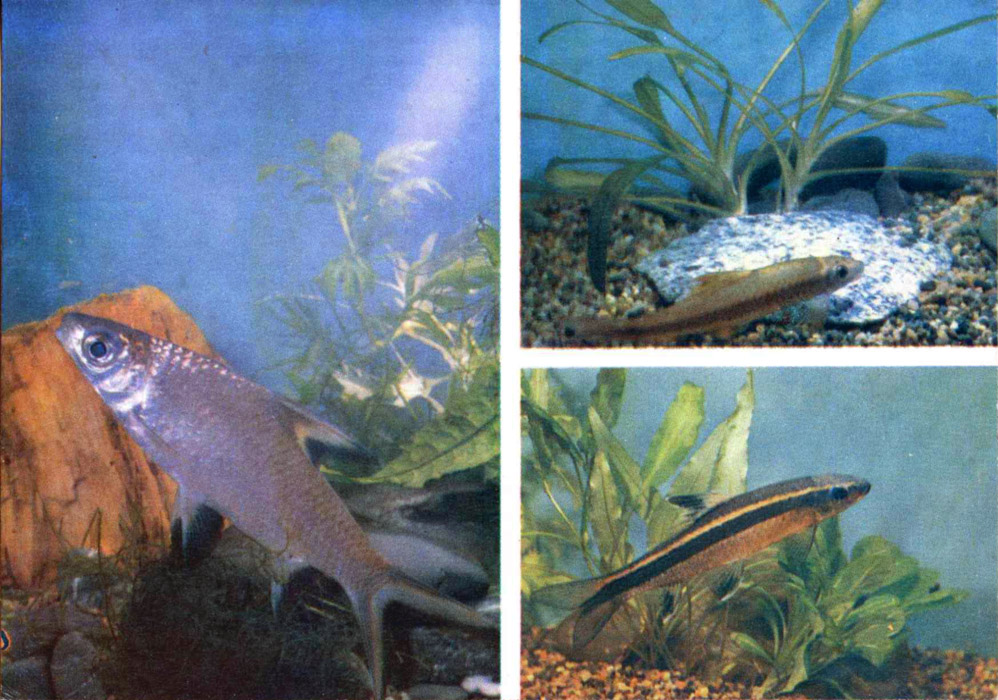 |
15. АКУЛИЙ БАЛА. Balantiocheilus
melanopterus.
15 — 36 см
СИАМСКИЙ ЭПАЛЬЦЕОРИНХ. Epalzeorhynchus siamensis. До 14 см
СУМАТРАНСКИЙ ЭПАЛЬЦЕОРИНХ. E. kallopterus. До 15 см
Населяют реки Юго-Восточной Азии. Самцы ярче, стройнее
самок.
1. Созревает в 2—3 года. Нерест порционный, Аквариум 150x60x60 см. Фитофил. Продуктивность
до 30 тыс. икринок. Инкубационный период 2 дня, t 27° С. Условия содержания и
кормления общие с барбусами. Продолжительность жизни до 10 лет.
2 и 3. Корм: детрит, перифитон, планктон, реже бентос. Созревают в 1,5 — 2 года.
Нерест сезонный, стайный. Пелагофил. Продуктивность 0,5 — 2 тыс. икринок. Инкубационный
период — сутки. Стартовый корм: микропланктон. Условия содержания: dH до 15°,
рН 6.5—7.5, t 22—28° С и т. д. Продолжительность жизни до 8 лет. Близкие виды:
E. stigmaeus — 12 см и E. coatesi — 14 см (Таиланд). |
1. Inhabit rivers of South-East Asia. Males brighter
and slimmer than females. Sexually mature at 2 to 3 years. Intermittent
spawning. Tank dimensions: 150x60x60 cm. Phytophil. Fecundity up
to 30.000 eggs. Incubation period 2 days at 27° C. Care and feeding
are common for Barbs. Longevity, up to 10 years.
2 and 3. Food; detritus, periphyton, plankton. seldom benthos. Sexually mature
at 1.5 to 2 years. Spawning seasonal, in schools. Pelagophil. Fecundity 500 to
2.000 eggs. Incubation period 24 hours. .Starting food: microplankton. Care:
dH to 15°, pH 6.5-7.5, temperature, 22 to 28° С, etc. Longevity, up to 8 years.
Close species: E. stigmaeus — 12 cm and E. coatesi — 14 cm (Thailand). |
Pueblan los rios del Sudeste de Asia. Los machos son mas vistosos
y de mas garbo que las hembras.
1. Pubescen a los 2-3 anos de vida. La puesta la hacen en varias porciones. Dimensiones
del acuario: 150x60x60 cm. Fitofilos. Productividad: hasta 30 mil huevos, el
periodo embrionario es de dos dias (t 27° C). Las condiciones de vida y alimentacion
son analogas a estas de las especies tipo Barbus. Viven hasta 10 anos.
2, 3. Pasto: detritus, periphyton, plancton con menos frecuencia
bentos. Pubescen en 1.5-2 anos. La muga es gregal y estacional. Son pelagofilos.
Productividad:
0.5-2 mil huevos. El periodo embrionario es de un dia con su noche. Paslo inicial:
microplancton. Viven hasta 8 anos. Especies afines: E. stigmaeus, 12
cm. у E.
coatesi, 14 cm., Tailandia. |
 |
Фото С. Кочетова. «Пестрый мир аквариума».
Выпуск 5. Карповые.
© «Планета», Москва, 1986. 24/8а-6971. Т. 500000. Ц. 3 коп. З. 2560. Тип.
.№ 2.
ОТПРАВЛЯТЬ ПО ПОЧТЕ ТОЛЬКО В КОНВЕРТЕ |
|
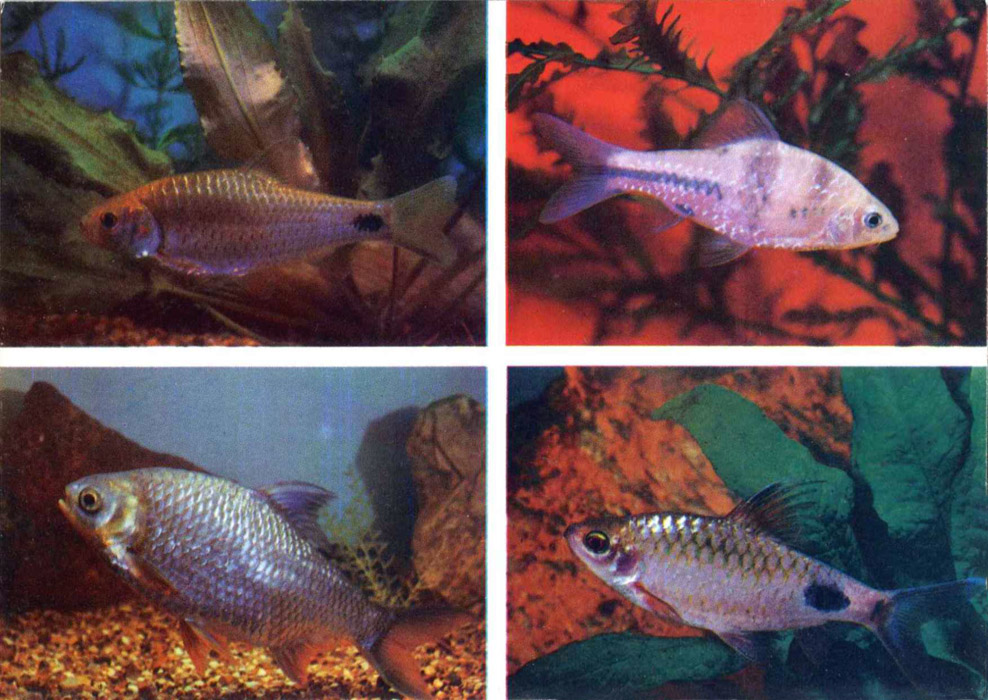 |
16. КРАСНОЩЕКИЙ БАРБУС. Barbus
orphoides.
10—25 см
КРЕСТОВЫЙ БАРБУС. В. lateristriga. До 18 см
ЛЕЩЕВИДНЫЙ БАРБУС. В. schwanefeldi. 15 — 35 см
ОЛИВКОВЫЙ БАРБУС. В. filamentosus. 15 см
Населяют водоемы Сингапура, Таиланда. Индии, Малайзии,
о. Явы, Суматры и т. д. Самый крупный азиатский барбус — B.
tor (до 2,5 м), мелкие виды: B. dorsimaculatus, B.
gelius, B. phutunio (около 4 см). Самцы ярче, стройнее самок. Корм: животный — 60%
и растительный — 40%. Созревают в 1 — 2 года. Нерест парный. Рыб
помещают в аквариум вечером, а утром начинается нерест. Размер
нерестового аквариума: 150—70 х 50—30 х 50—30 см. Продуктивность
1,5 — 10 тыс. икринок. Инкубационный период 36 — 48 часов, еще
через 3 дня молодь плывет. Стартовый корм: мелкий планктон, микрокапсулированный
комбикорм, микрочервь и т. д, Условия содержания общие для рода.
Продолжительность жизни 7 — 12 лет. |
Inhabit waters of Singapore,
Thailand, India, Malaysia, Java. Sumatra, etc. The largest Barb
among Asiatic species — B.
tor (up to 2.5 m), small species: B. dorsimaculatus, B.
gelius,
B. phutunio (4 cm about). Males brighter and slimmer than females.
Food: 60% animal and 40% vegetable. Sexually mature at 1 to 2 years.
Spawning in single pairs. Spawners are to be put into the tank
at night, and in the morning the spawning begins. Tank dimensions:
150 to 70x50 to 30x50 to 30 cm. Fecundity 1,500 to 10,000 eggs.
Incubation period 36 to 48 hours, 3 days later the young start
swimming. Starting food: small plankton, combined micro-food, microworms,
etc. Care: common for the genus. Longevity, 1 to 12 years. |
Habitan las aguas de Singapur, Tailandia, India, Malasia, Java,
Sumatra, etc. El mayor Barbus asiatico — В. tor — alcanza 2,5 metros
de largo. Especies menores: B. dorsimaculatus, B.
gelius, B. phutunio (cerca de 4 cm.). Los machos son de colores mas vivos y de mas
garbo que las hembras. Pasto: animal (60%) y vegetal (40%). Pubescen
en 1-2 anos. Celebran la muga en parejas. Se las traslada al anochecer
a un acuario aparte, y a la manana siguiente comienza la puesta,
Dimensiones del acuario para mugas: 150-70x50-30x50-30 cm, Productividad:
1,5-10 mil huevos. En unas 36-48 horas se culmina el periodo embrionario
y a los tres dias la cria ya se desplaza en el agua. Pasto inicial:
plancton menudo, alimenos compuestos microgranulados, microlombrices,
etc. Las condiciones vitales son comunes para todo el genero. Viven
de 7 a 12 anos. |
 |
Фото С. Кочетова. «Пестрый мир аквариума».
Выпуск 5. Карповые.
© «Планета», Москва, 1986. 24/8а-6971. Т. 500000. Ц. 3 коп. З. 2560. Тип.
.№ 2.
ОТПРАВЛЯТЬ ПО ПОЧТЕ ТОЛЬКО В КОНВЕРТЕ |
|
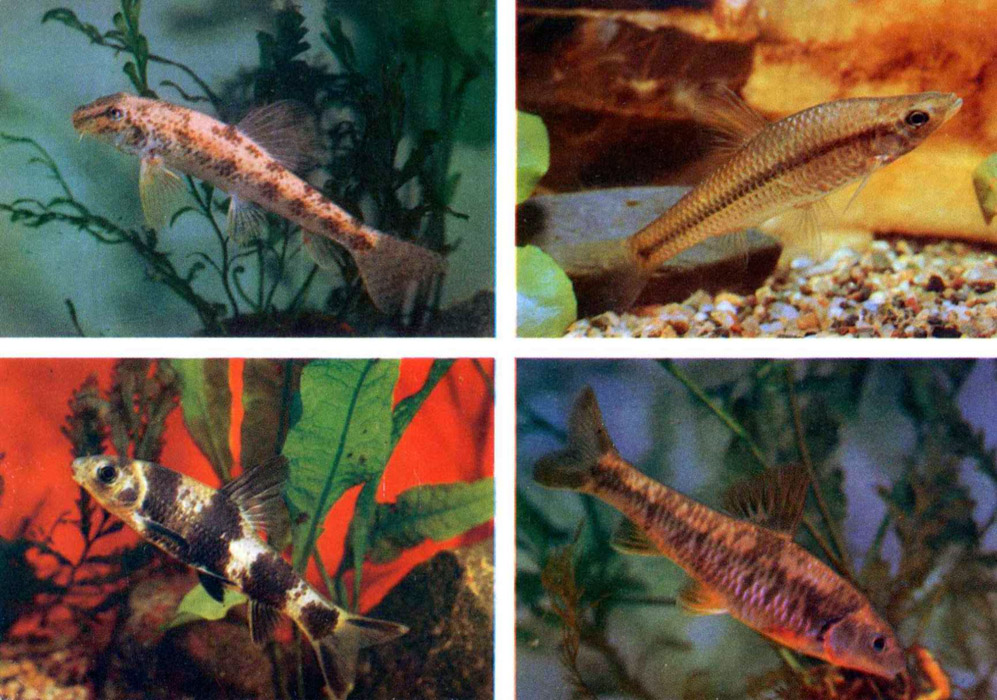 |
17. АМУРСКИЙ ЛЖЕПЕСКАРЬ. Pseudogobio
rivularis. До 11 см
АМУРСКИЙ, ИЛИ КИТАЙСКИЙ ЧЕБАЧЕК. Pseudorasbora parva. До 12 см
ПЕСКАРЬ-ЛЕНЬ. Sarcocheilichthys sinensis lacustris. До 28 см
ПЕСКАРЬ-ГУБАЧ СОЛДАТОВА. Chilogobio soldatovi. До 12 см
Населяют р. Амур. Самцы крупнее, стройнее и ярче
самок. Корм: животный — 80% и растительный — 20%. Созревают в 1—2
года. Нерест порционный, парный.
1. Псаммофил. Продуктивность 0,5 — 1 тыс. икринок (d~2,4 мм) Самец охраняет кладку.
Инкубационный период 4 дня, t 22° С, еще через 3 — 5 дней молодь плывет. Близкий
вид: P. esocinus — 22 см (Япония).
2. Литофил. Продуктивность до 500 икринок (d~2 мм) — 8 — 14 порций в году. Самец
охраняет кладку. Близкий вид: Ps. pumila — 8 см (Япония).
3. Остракофил, на течении икра плавает. Продуктивность 3 — 18 тыс. икринок (d~5
мм). Инкубационный период 60 часов, t 26° С. Близкий вид: S. variegatus — 20
см (Япония).
4. Продуктивность 0,5 — 2 тыс. икринок (d~4 мм), Личинка начинает питаться через
10 дней, t 22° С. Близкий вид: Ch. czerskii — 9 см. |
Inhabit the Amur River. Males bigger, slimmer and
brighter than females. Food: 80% animal and 20% vegetable. Sexually
mature at 1 to 2 years. Intermittent spawning, in single pairs.
1. Psammophil. Fecundity 500 to 1,000 eggs (d~2.4 mm). Male protects the cluth.
Incubation period 4 days at 22° C, 3 to 5 days later the young start swimming.
Close species: P. esocinus — 22 cm (Japan).
2. Litophil. Fecundity up to 500 eggs (d~2 mm), 8 to 14 batches a year. Male
protects the clutch. Close species: Ps. pumila — 8 cm (Japan).
3. Ostracophil, the eggs are pelagic at current. Fecundity 3,000 to 18.000 eggs
(d~5 mm). Incubation period 60 hours at 26° C. Close species: S. variegatus —
20 cm (Japan).
4. Fecundity 500 to 2,000 eggs (d~4 mm). The fry starts feeding 10 days later
at 22° C. Close species: Ch. czerskii — 9 cm. |
Son habitantes del rio Amur. Los machos son mas grandes, garbosos
y de colores mas vivos que las hembras. Pasto: animal (80%) y vegetal
(20%). Pubescen en 1-2 anos. Celebran la muga en parejas, la puesta
la hacen en varias porciones.
1. Psamofilos, Productividad: 0,5-1 mil hincos (D=2,4 mm). El macho cuida de
la puesta. El periodo embrionario es de 4 dias, t 22° C, en 3-5 dias los alevines
se desplazan ya en el agua. Especie afin: P. esocinus, 22 cm., Japon.
2. Litofilos. Productividad: hasta 500 huevos (D = 2 mm), de 8 a 14 porciones
al ano. El macho custodia la puesta. Especie afin: Ps. pumila. 8 cm., Japon.
3. Ostracofilos, mas en aguas corrientes los huevos flotan en suspenso. Productividad:
3-18 mil huevos (D = 5 mm). El periodo embrionario es de 60 horas. t. 26° С.
Especie afin: S. variegatus, 20 cm., Japon.
4. Productividad: 0,5-2 mil huevos (D = 4 mm). Los alevines empiezan a procurarse
pasto al pasar 10 dias, t 22° C. Especie afin: Ch. czerskii, 9 cm. |
 |
Фото С. Кочетова. «Пестрый мир аквариума».
Выпуск 5. Карповые.
© «Планета», Москва, 1986. 24/8а-6971. Т. 500000. Ц. 3 коп. З. 2560. Тип.
.№ 2.
ОТПРАВЛЯТЬ ПО ПОЧТЕ ТОЛЬКО В КОНВЕРТЕ |
|
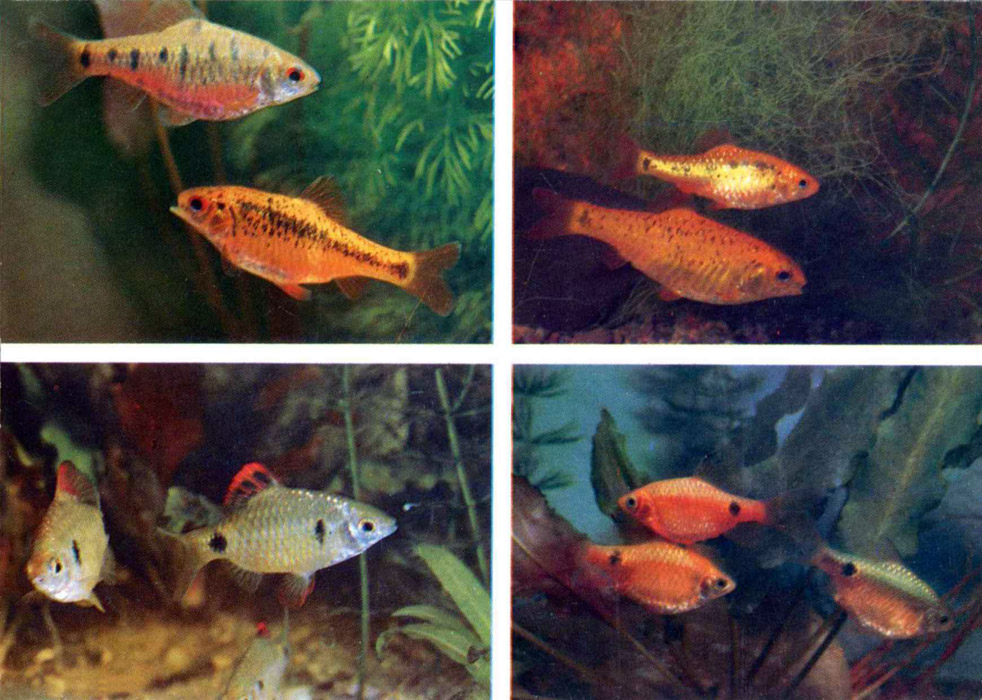 |
18. ЗЕЛЕНЫЙ БАРБУС. Barbus
semifasciolatus. 7 — 10 см
БАРБУС ШУБЕРТА. B. s. var. schuberti. 7 см
АЛОПЛАВНИЧНЫЙ БАРБУС. B. stoliczkae. 6 см
ОГНЕННЫЙ БАРБУС. B.conchonius. 6 — 14 см
Населяют водоемы юга Китая. Вьетнама, Бирмы и Индии.
Из азиатских барбусов в аквариумах содержат около 40 видов. Самцы
мельче, стройнее самок, ярче окрашены. Корм: животный — 70% и растительный
— 30%. Созревают в 5 — 7 месяцев. Нерест порционный до 8 раз в
году. Перед нерестом производителей на 10 — 15 дней разделяют и
разнообразно кормят. Размер нерестового аквариума 40x25x25 см.
Фитофилы. Продуктивность до 1000 светло-желтых икринок (в среднем
300 — 500 шт.). Инкубационный период 20 — 30 часов, еще через 3
— 4 дня молодь плывет. Стартовый корм: парамеция, науплии циклопа
и т. п. Условия содержания: dH до 20°, рН 6.5 — 7,5, t 22 — 26°
С и т. д. Продолжительность жизни 3 — 5 лет. |
Inhabit waters in the south of China, Vietnam. Burma
and India. About 40 species among Asiatic Barbs are kept in aquaria.
Males smaller, slimmer and brighter than females. Food: 70% animal
and 30% vegetable. Sexually mature at 5 to 7 months. Intermittent
spawning up to 8 times a year. Spawners should be separated and
fed with varied foods for 10 to 15 days before expected spawning.
Spawning tank dimensions: 40x25x25 cm. Phytophils. Fecundity up
to 1,000 light-yellow eggs (300 to 500 on average). Incubation
period 20 to 30 hours. 3 to 4 days later the young start swimming.
Starting food: slipper limpet. Cyclops nauplii, etc. Care: dH to
20°: pH 6,5-7.5, temperature 22 to 26° С, etc. Longevity, 3 to
5 years. |
Pueblan las aguas dulces de la China meridional. Vietnam. Birmania
e India. De las especies asiaticas de Barbus, son cultivadas en
acuarios cerca de 40. Los machos ceden a las hembras en tamano
ganandoles, en cambio, en vistosidad. Pasto: animal (70%) y vegetal
(30%). Pubescen a los 5-7 meses. La puesta, en varias porciones,
hasta 8 veces al ano. En visperas de la muga se los separa a los
progenitores por unos 10 a 15 dias, variandose su alimento en este
periodo. Dimensiones del acuario para mugas: 40x25x25 cm. Son fitofilos.
Productividad: hasta mil huevos amarillentos (de 300 a 500, por
lo general). El periodo embrionario no dura mas de 20-30 horas;
a los 3-4 dias los alevines empiezan a desplazarse en el agua.
Pasto inicial: paramecios, nauplias de ciclopes, etc. Condiciones
vitales: dH hasta 20°; pH 6,5-7.5; t 22-26° C. etc. Viven de 3
a 5 anos. |
 |
Фото С. Кочетова. «Пестрый мир аквариума».
Выпуск 5. Карповые.
© «Планета», Москва, 1986. 24/8а-6971. Т. 500000. Ц. 3 коп. З. 2560. Тип. .№
2.
ОТПРАВЛЯТЬ ПО ПОЧТЕ ТОЛЬКО В КОНВЕРТЕ |
|
